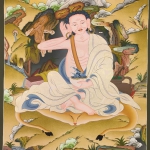About Dark retreat

Dark retreat is a solo retreat in a space that is completely absent of light, which is an advanced practices in the Dzogchen lineages of the Nyingmapa, Bönpo, and other schools of Tibetan Buddhism. The time period dedicated to dark retreat varies from a few hours to decades. Dark retreat in the Himalayan tradition is a restricted practice only to be engaged by the senior spiritual practitioner under appropriate spiritual guidance. This practice is considered conducive for navigating the bardo at the time of death and for realising the rainbow body. The traditional dark retreat requires stability in the natural state and is only suitable for advanced practitioners. Ayu Khandro and Dilgo Khyentse are examples of modern, if not contemporary, practitioners of significant periods of dark retreat sadhana.



























